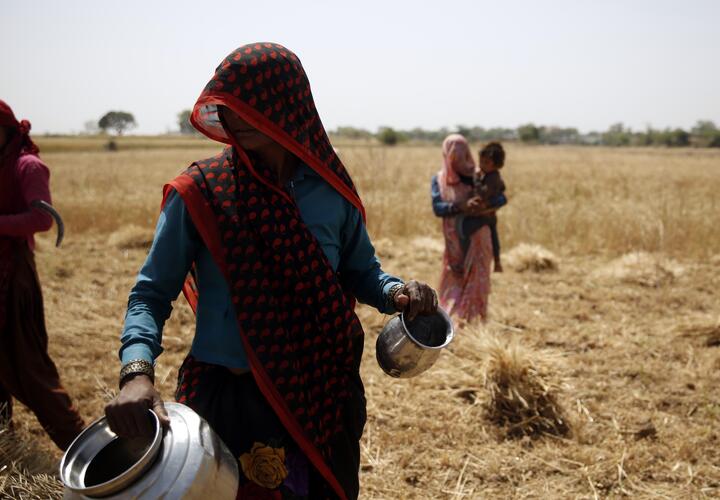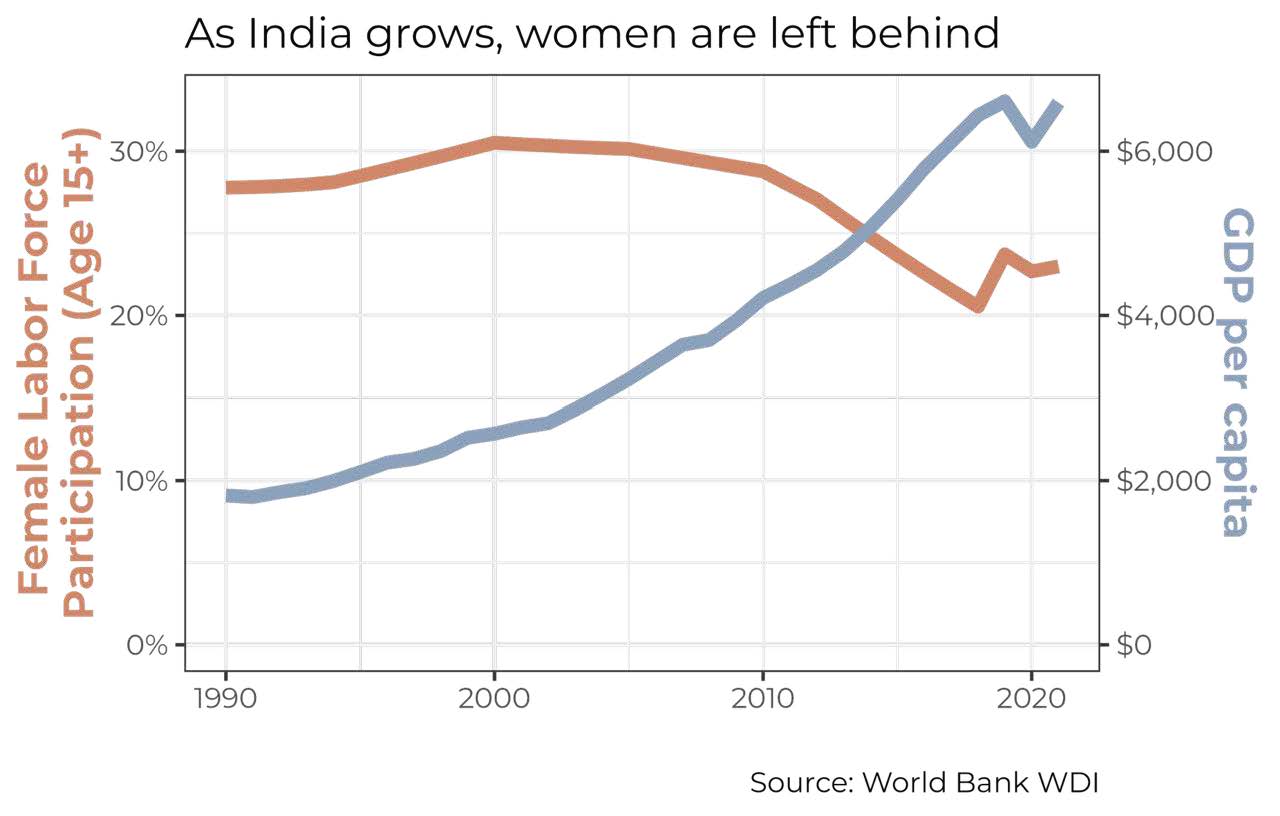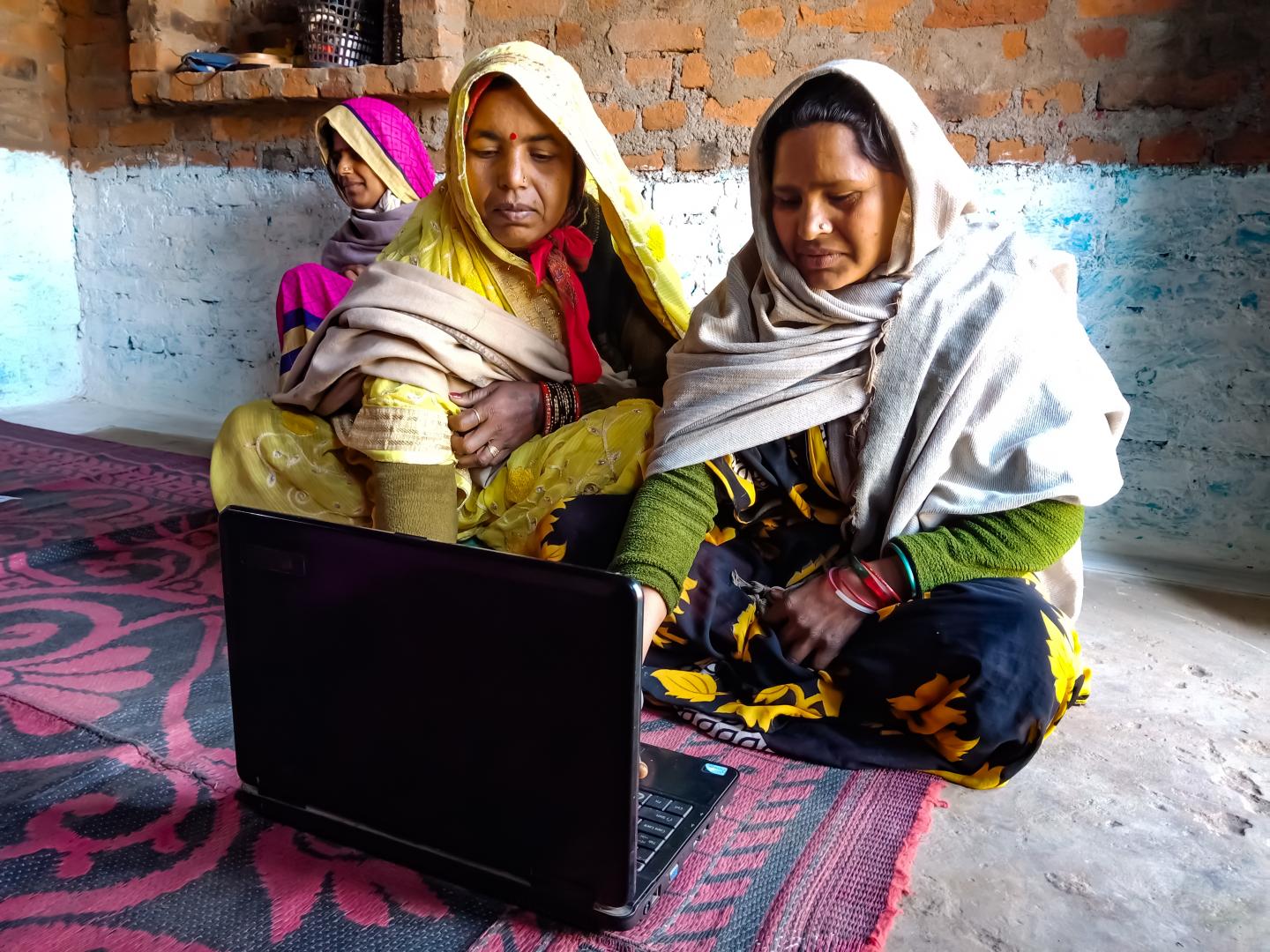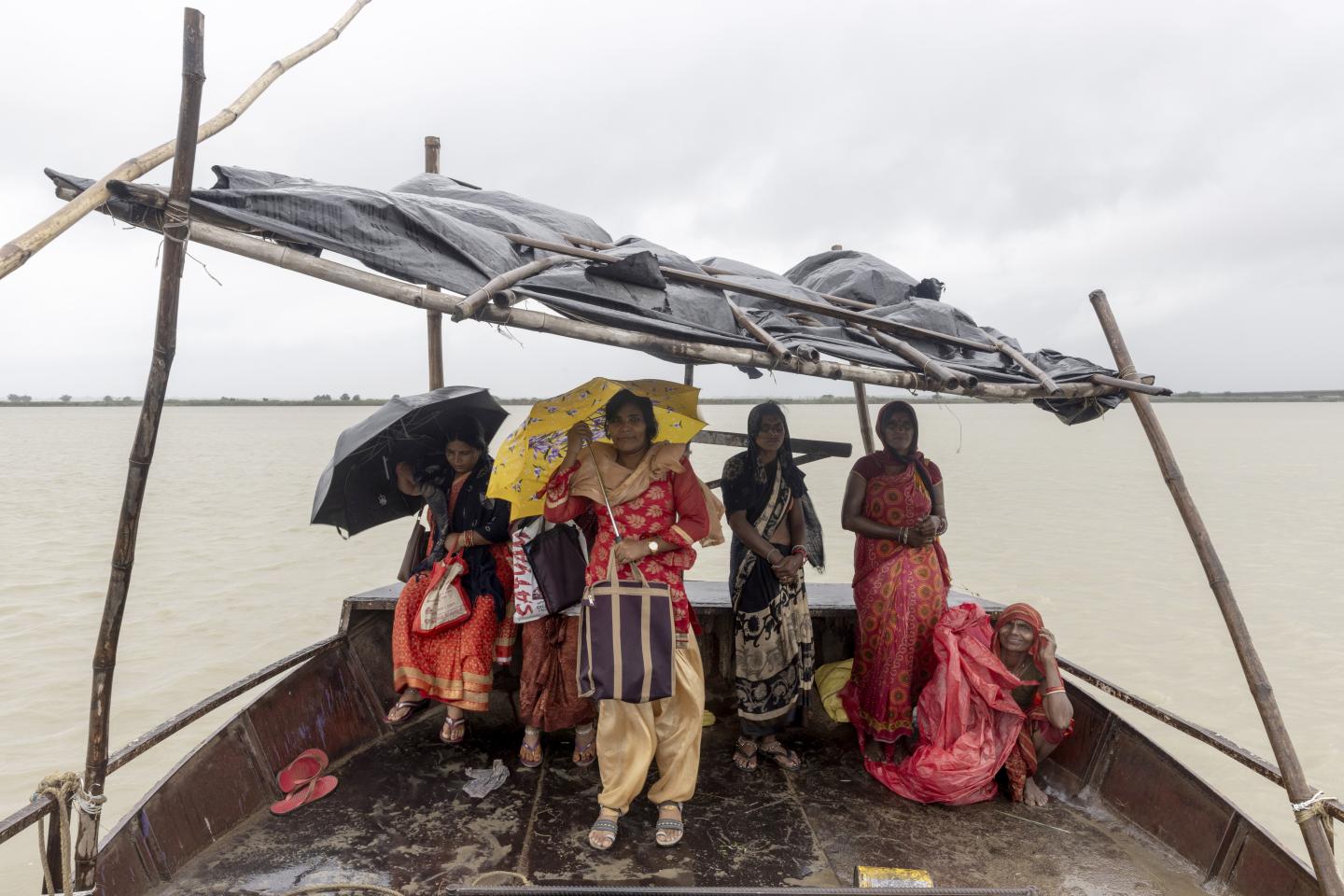Insights from 10 years of research on women's opportunities
Inclusion Economics affiliates have conducted a decade of research on women's economic lives in India. Here, the research leadership of Yale Inclusion Economics asks, What progress have Indian women made, and where should we go from here?

In 2013, our team of researchers affiliated with Inclusion Economics at Yale University and the Inclusion Economics India Centre (formerly known as EPoD India) began a set of studies to understand Indian women’s economic and social challenges, ranging from limited job opportunities in rural areas to low bank account ownership and financial inclusion, and to restrictive social norms. There were many concerns: Globally, India ranked in the bottom 10 percent of all countries on the basis of gender gaps in economic participation and opportunity.1 And despite consistent growth in GDP per capita, women’s labor force participation has been declining for over 10 years (see figure).
 Nils Enevoldsen
Nils Enevoldsen
A decade later, there is much to celebrate: the gender gap in bank account ownership, which was 18 percentage points in 2011, has closed, as over 282 million women opened accounts under the world's largest account-opening initiative.2 Virtually every woman has a digital identity, and many use their own phone – but the use of higher-value functions such as digital financial services lags. Self-help groups,3 which the government initially supported to give women access to small loans, have rapidly expanded their reach and scope over the past decade, now providing a platform for women's broader socioeconomic engagement, with over 90 million women participating. Although informal power structures, especially social norms, still hinder women’s economic activity, their importance in perpetuating gender inequalities is now widely acknowledged.
Yet, significant gender gaps persist, including in labor force participation; in digital inclusion, where Indian women are still 40 percent less likely than men to access mobile internet;4 and in business ownership and leadership.
Our research over the past decade has focused on formal and informal power structures that inform women’s economic opportunity and social empowerment, as well as economic, community, and home-based constraints that perpetuate inequality. From Bihar to Chhattisgarh to Madhya Pradesh to Odisha, we’ve collaborated closely with public and private sector stakeholders and citizens from diverse societal backgrounds both men and women. We have analyzed secondary data to highlight emerging trends, worked with policymakers to ensure easy access to administrative data, and collaborated with state and central government partners to conduct process evaluations and large-scale field experiments. We have also ensured that we follow our study populations over longer time periods to track how program impacts influence, and are influenced by, local dynamics.
Our insights are informed by gender-sensitive diagnostics that combine quantitative data with deep-dive qualitative approaches to understand women’s unique experiences and the demand- and supply-side features that affect women’s labor market activity, digital gender gaps, and access to safety net transfers. We conduct rigorous analysis using “at-scale” randomized controlled trials and quasi-experimental analysis to understand what works to support women and use theory and qualitative insights to understand “the why” behind it. Crucially, we undertake this research in the context of years-long research-policy engagements, working directly with state and private sector counterparts at multiple levels to understand what questions are relevant to decision makers, and to ensure research informs responses to those questions. Our work with the central, state, district and lower levels of government in rural development is an example of this form of collaboration.
What have we learned through this work, and what critical questions must we answer going ahead given what we know about future challenges for women in India and other LMICs?
While our research focuses on specific policy levers to help women, it also highlights common building blocks needed for a more gender-equitable future. These include gender-inclusive infrastructure and investing in women’s capabilities, empowering women as change agents, and challenging entrenched power structures. Our research has shown that when policy takes this focus, and is deeply informed by the local context and conducted in the context of long-term research policy engagements, it can transform women’s opportunities, allowing them to flourish and thrive.
 EERAZ CHATURVEDI Shutterstock
EERAZ CHATURVEDI Shutterstock
Research-Backed Insights
Here, we describe what we’ve learned about these building blocks from our research over this time, and what can and cannot enact them.
Build gender-inclusive infrastructure and invest in women’s capabilities - particularly to engage with innovations in digital public infrastructure.
Successful investments not only provide women opportunities; they also give women a reason to use them. For example, India’s bank account drive coincided with an expansion of direct benefit transfers via these accounts and investments to expand access points. Women gained a tool to control their financial resources, alongside increased access to these resources. Our research in Madhya Pradesh highlights the importance of these simultaneous interventions: Opening a bank account alone did not change women’s lives much. Even informing women about when payments were made into their accounts, while helpful in increasing knowledge of account information and trust in agents, did not increase account activity. Instead, ensuring women had both a reason to use the account (to access their digital workfare payments), and strengthening their capabilities to access these transfers, increased women’s economic activity and liberalized their views on whether it was appropriate for them to work outside their homes.
Similar insights emerge from our work focused on women’s access to mobile phones. In 2018, the government of Chhattisgarh provided low-income women with smartphones and free mobile data, while installing mobile towers in rural areas. The fact that this program was only implemented in villages that met a population threshold allows us to evaluate the program’s causal impact. Using a quasi-experimental study to compare villages just above the threshold (treated villages) to those just below (control villages), we see that, in the short term, women and their husbands in treated villages were more likely to report phone ownership. In these villages, the husbands were more likely to state that men had more use for a phone than women. Four years later, women’s phone use and the digital gender gap were indistinguishable across treated and control villages. Why did these massive investments not increase women’s use of phones? One possibility is that women needed more than just gender-inclusive infrastructure to access new digital technology. Instead, this infrastructure must also support women to invest in their capabilities, ensuring they have both the opportunity and ability to use these investments.
This hypothesis is supported by a complementary evaluation conducted in the same setting in rural Chhattisgarh: a short group training that was used to teach the fundamentals of smartphone use to women who had received phones through this program increased women's phone use and closed digital gender gaps in the long-term, three years after the training took place. And, in addition to phone use, digital literacy training expanded women’s social networks and reduced their risk of depression by 7 percentage points compared to those who received phones but no digital literacy training.
This is not the first time group training has been impactful: On multiple occasions, we have seen the power of group-based training to empower women to access female-friendly infrastructure. In another example in northern Madhya Pradesh, sending women wage payments via direct deposit proved more effective when combined with training to support women's access to banking agents and payments.
Use policy to empower women as change agents.
One crucial way to empower women is to support their employment as frontline government workers. Policy initiatives can support women’s economic opportunities: the Indian government hires local women to provide healthcare, childcare, and increasingly to lead self-help groups. It also helps women get started as banking agents and, more recently, as local auditors of government programs. Our systematic monitoring of women’s experiences working for the government in Bihar shows that these programs provide significant opportunities; however, there is room for improvement: women’s banking businesses can take months to start, technical issues sometimes limit their work; and new agents often voice a need for additional training. Despite these challenges, regular surveys of these women suggest that they thought they had more input in home decisions and received more respect from their communities as a result of the role they now play.
Women’s experiences as community auditors are similarly illustrative of the challenges and opportunities of employing women to increase local accountability. In interviews with women employed as “Social Audits Resource Persons”, who were tasked with auditing the implementation of flagship safety net programs, we found that, unsurprisingly, family responsibilities made it difficult for women to be away from their homes for long periods of time. Administrative obstacles were also prevalent; in the first year of the program, nearly 2 in 3 women left their jobs as their payments were delayed while government officials finalized the payment infrastructure. Qualitative interviews suggested that women who persevered in their jobs sometimes did so in the hope of gaining a prized position as a long-term government worker. Despite the numerous challenges they faced, women reported enjoying their work as frontline government workers, particularly being able to inform community members about their entitlements and rights. Fortunately, government resources have been directed to address many of these challenges and improve women’s experiences as auditors.
These investments in frontline workers must be aligned with the tasks they are given. In research in Odisha, we saw that frontline workers were not very effective recruiters for young women to join job-linked vocational training, yet giving higher-level officers responsibility for recruitment doubled young women’s training enrollment. In this case, female frontline workers lacked information, experience, and social status to navigate the multiple barriers that kept young women from joining training and jobs outside their home villages. Instead, equipping female frontline workers to support higher-level recruitment efforts (encouraging youth to attend local recruitment camps) may be a more effective approach than training them in areas they lack context and expertise (i.e., advising young people about joining training programs and migrating to urban areas).
Challenge entrenched power structures while elevating women’s voices.
To effectively empower women, policies must recognize how female-friendly policies challenge entrenched power structures while elevating women’s voices. Tacit and explicit initiatives to let women engage as economic agents challenge entrenched power structures. We are learning how power dynamics, often operating through restrictive social norms, constrain women’s and other marginalized groups’ opportunities. Working again with women in rural Madhya Pradesh, we identified and quantified how husbands' concerns about social stigma and shame associated with being viewed as poor providers drove restrictive beliefs about women's work outside the home. Strengthening women’s power within the household by sending safety net payments directly to her, rather than her husband, challenged and loosened the grip of those norms. In surveys three years after working to empower women financially, women reported they thought it was more appropriate for women to work outside the home and were more likely to aspire to have working daughters and daughters-in-law. Three years later, perceptions of community members’ views also liberalized among both women and men, a crucial piece in the evolution of women’s roles.
Core investments in inclusive infrastructure and investing in women’s capabilities can also help elevate women’s voices to those with power: Smartphone distribution, combined with digital literacy training, enabled women to engage with a program known as “My Voice” in rural Chhattisgarh, where women participated in regular phone surveys about their experiences with public services and programs. Survey results were shared directly with government partners and armed decision makers with information on women’s knowledge of Covid and experiences through the pandemic, as well as information on services targeting anemia. Similarly, during the pandemic, we reached out to over 300,000 migrant workers using interactive voice response (IVR) surveys, allowing them to share information about their current challenges with their state government counterparts. Alongside, we gathered data on real-time demand for safety net work under MGNREGS from over 70,000 returned migrant workers, sharing requests for work with the government, and highlighting how these broad platforms can reach marginalized populations and provide a way for them to speak directly to the state.
While we lack causal evidence on the impact of elevating women’s voices – for example, through understanding the impact of the “My Voice” program on government decisions – we see this as an important area of future research.
Looking ahead: A research-policy agenda that works for women
We have learned about what happens to women during economic shocks, such as those imposed by the Covid-19 pandemic. The news here suggests challenges ahead, both for India and globally. Economic losses through the pandemic were disproportionately large and persistent for women in urban India; our analysis of data focused on migrant workers’ experiences found that former female migrant workers were significantly less likely to be working than their male counterparts at each of the four times we interviewed them, up to 15 months after the pandemic began. Government efforts to support vulnerable women were commendable, and certainly useful, but – despite the impressive bank account coverage – likely missed many women, and initial efforts meant women frequently had to rely on others to access vaccines.
We also see evidence that views related to women’s roles in economies, a key enabler of individual and household-level empowerment, may reflect shocks and scarcity. In global World Values Survey data, individuals who reported having gone without an income more frequently in the past year were more likely to agree that men should have more rights to a job than women when jobs are scarce. These views differed by gender: Men facing economic scarcity were over 20 percentage points more likely to agree with this statement than similar women.
Women themselves will have to navigate upcoming shocks, as well as potential resistance to gains in agency and economic opportunities. In a survey we conducted 3 years after the pandemic began, and 8 years after we supported women in accessing direct deposit payments on their own in rural Madhya Pradesh, we see that the women that gained the most in terms of economic opportunities, agency, and liberalized norms, still experienced many of those benefits despite the pandemic’s effects. However, they also reported relatively higher perceptions of community disapproval of women working and friction in the household.
Designing a forward-looking research agenda must reflect the learnings described here and be paired with an understanding of the world ahead. Unfortunately, major global challenges will likely only expand over the next decade, with climate change and its consequences, along with technological advancements, fundamentally reshaping economic, political, and social interactions and women’s well-being. Yet India’s intentional investments and some recent progress have laid a foundation that is now capable of elevating women in the economy and society. What do we need to understand to ensure women can thrive despite these long-term challenges?
Given all we have learned and the challenges and opportunities on the horizon, we see several crucial areas for future research-policy collaboration.
 Ishan Tankha
Ishan Tankha
First, our understanding of the effects of climate change on women in lower-income settings is still nascent; we need to better understand how to support women through upcoming climate-linked challenges, and whether the platforms governments have built can be used to inform and equip women to reduce the impact of climate shocks, particularly those that can be predicted, like local floods or heat waves. An initial step here is to better understand the overlap between women’s felt needs and the government’s ability to support them.
Second, we aim to unpack the driving forces behind restrictive views on women’s economic activities. A key objective here is to develop and test measures of gender norms that can be used in surveys beyond India, similar to our work on women’s time use. Alongside improving the measurement of these difficult-to-measure issues, we seek to understand how to encourage those in power, such as husbands, to support sharing opportunities with those with less power – in this case, wives. We will aim to understand these challenging issues around gender norms better through studies examining digital-based work opportunities for women – a promising avenue for women to earn their own income, but only if digital gender gaps can also be closed.
In terms of challenging power structures, we are working with local NGOs to understand how to improve accountability and women’s experiences at local financial institutions, where women often receive poor service but have little recourse to address problems.
A final important opportunity is to understand how proliferating women’s groups, supported through the National Rural Livelihoods Mission, can more systematically engage patriarchal power structures such as those in traditional local leadership to ensure women’s interests are better represented in local policy decisions, and others can benefit from these investments. This group-based platform has developed local infrastructure that is increasingly being leveraged to empower women socially and help them tap into economic opportunities. We see significant scope to better understand and promote these high-potential opportunities delivered through self-help group federations to increase their impact on women and their communities.
We believe these questions will be best addressed through the type of long-term policy-research engagements we have conducted over the past decade, which aim to work with policy counterparts to define the right research questions, rigorously understand challenges and solutions, and input directly into future policy decisions.
1. World Economic Forum Global Gender Gap Report 2013. Available here; accessed November 21, 2023.
2. Global Findex data. Available here; accessed November 21, 2023.
3. According to NRLM data table G.1., “SHGs under NRLM”, accessed November 20, 2023.
4. GSMA Mobile Gender Gap Report 2023. Available here; accessed November 21, 2023. “Access” refers to use of the internet from a mobile phone (not necessarily one’s own) in the past 3 months.